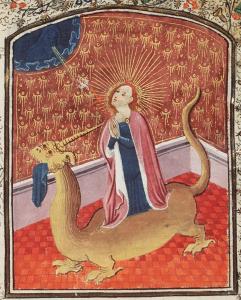
Hagiography and Truth
Each year in preparation for teaching my 12th grade students Chaucer’s Canterbury Tales, I teach a brief unit about hagiography–the legends of the lives (and martyrdom) of the saints. The legends themselves are a fascinating study, and whether or not they are 100% accurate, they do teach truth.
First of all, the person introduced in the legend is believed to have actually existed. Second, the stories teach biblical truth, lessons to apply to our own lives when striving for holiness. Third, they relay the religious values and attitudes of their times, played out as the sacrificial body-as text.
One of my students’ favorites is the story of Margaret of Antioch. It may be a favorite because they are high school students and the story is brutal and bloody and they can’t believe this old lady teacher is actually exposing them to it. OK, well, old lady or not, martyrdom was (and is) a brutal and bloody thing, and that fact should not be sterilized. It is also interesting to them that the martyr was a woman.
Women in Hagiography
Thomas Head, Hunter College and the Graduate Center, CUNY in the article “Women and Hagiography in Medieval Christianity,” states that “sanctity is in a very fundamental way a social or institutional construct. Sanctity is an ideal which developed historically: different sorts of people were recognized as saints by Christian communities during different periods. One of the most important factors in the changing character of sanctity over the course of the middle ages was gender. The recognition of, or more importantly the failure to recognize, women as saints betrays many of the misogynist traits typical of medieval society and culture. While most medieval theologians conceded a theoretical equality between men and women in their ability to be saved, they almost uniformly saw men as more likely to practice the virtues necessary for salvation. Thus Athanasius (+373) claimed that female martyrs demonstrated how something ‘against nature’ (that is, female bravery) could give proof of something ‘higher than nature’ (that is, the truth of Christianity). Moreover women were excluded from the Christian clergy and thus from the callings which produced the majority of saints recognized during certain periods. Throughout the middle ages women were a distinct minority among those Christians whose reputation for holiness received public celebration and thus earned for them the title of saint.”
The Legend of Margaret of Antioch
Who was Margaret of Antioch? Also known as Marina, she is the patron saint of pregnant women and childbirth, especially difficult childbirth, servant maids, and an advocate against diabolical infestation. Margaret was particularly famous during the Middle Ages. Joan of Arc is said to have heard her voice of counsel as one of the 14 Holy Helpers.
Margaret was born in Pisidian Antioch in Asia Minor. Her father, Theodosius, was a pagan ruler and priest. Her mother died shortly after Margaret’s birth. Margaret’s father then sent her into the care of a pious woman who raised her in Christianity. Drawn to Christ in a particularly passionate way at a young age, Margaret dedicated her life to Christ and pledged Him her virginity. Theodosius disowned her, and Margaret was adopted by the woman who raised her.
According to the legend, Margaret grew to be exceptionally beautiful. She became a shepherdess, and one day when she was out with the sheep, the lustful prefect Olybrius spotted her. He was infatuated and ordered her to be brought to him. He said he would make her his concubine and even marry her, but she refused, explaining that she would not be violated as she had pledged her virginity to her Savior. Olybrius became furious and had her taken to prison, hung up on iron hooks, and beaten until she might accept him. Here is the rest of Margaret’s ordeal:
The Martyrdom of Margaret
“And whilst she was in prison, she prayed our Lord that the fiend that had fought with her, would visibly show him unto her. And then appeared a horrible dragon and assailed her… and he swallowed her into his belly, she making the sign of the cross. And the belly brake asunder, and so she issued out all whole and sound.”
[The next part is rather cartoonish, kind of amusing, yet represents the outrageous power of a passionate God.]
“After this the devil appeared to her in likeness of a man for to deceive her. And when she saw him, she went to prayer and after arose, and the fiend came to her, and took her by the hand and said: It sufficeth to thee that thou hast done, but now cease as to my person. She caught him by the head and threw him to the ground, and set her right foot on his neck saying: Lie still, thou fiend, under the feet of a woman. The devil then cried: O blessed Margaret, I am overcome. If a young man had overcome me I had not recked, but alas! I am overcome of a tender virgin; wherefore I make the more sorrow, for thy father and mother have been my good friends.
“She then constrained him to tell why he came to her, and he answered, that he came to her to counsel her for to obey the desire and request of the provost. Then she constrained him to say wherefore he tempted so much and so often Christian people. To whom he answered that naturally he hated virtuous men, and though we be oft put aback from them, yet our desire is much to exclude them from the felicity that they fell from, for we may never obtain ne recover our bliss that we have lost.
And she then demanded what he was, and he answered: I am Veltis, one of them whom Solomon closed in a vessel of brass. And after his death it happed that they of Babylon found this vessel; and supposed to have founden great treasure therein, and brake the vessel, and then a great multitude of us devils flew out and filled full the air alway, awaiting and espying where we may assail rightful men. And when he had said thus, she took off her foot and said to him: Flee hence, thou wretched fiend. And anon the earth opened, and the fiend sank in. Then she was sure, for when she had overcome the master, she might lightly overcome the minister.”
https://brightonoratory.org/2012/07/20/todays-saint-st-margaret-of-antioch-virgin-martyr/
According to the legend, “the next day, attempts were made to execute her by fire and then by drowning, but she was miraculously saved and converted thousands of spectators witnessing her ordeal-all of whom were promptly executed. Finally, she was beheaded. That she existed and was martyred are probably true; all else is probably fictitious” (Catholic Online). At her death, Margaret offered blessings to all those who would call upon her or who would spread her story.
Margaret Celebrated Today
From the 12th to the 20th century, Margaret was commemorated by the Catholic Church. She is celebrated by the Church of England on July 20. In 2022, the Episcopal Church added her feast to the liturgical calendar on November 24. The Eastern Orthodox Church celebrates her as St. Marina on July 17.













